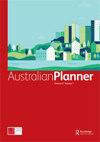Where have all the backyards gone? The decline of usable residential greenspace in Brisbane, Australia
IF 1.2
Q2 Social Sciences
引用次数: 1
Abstract
ABSTRACT Urban design impacts all aspects of our lives – economic, social and environmental. Government planning policies aim for clean, green, sustainable growth, encouraging residential development close to major infrastructure and parks; and advocate protection of greenspace to enhance livability, health and wellbeing. Using an inner-suburb of Brisbane as a case study, this research evaluated policy outcomes by analysing residential development applications, to identify gaps between the policy intent and implementation. The key measurable outcome criteria selected for this policy evaluation included: dwelling density; zone category, type and built-form totals; major shopping centres, transport infrastructure and parks proximity; tree removal and replacement totals; residential greenspace area totals and additional public greenspace provision. The methods are adaptable to policy evaluation locally, nationally and internationally. The research identified significant gaps between the intent and implementation of planning policies, finding residential development outcomes did not comply with the policy intent; and highlighted the importance of effective governance through policy evaluation. The findings indicated a critical need for legislative amendment to improve compliance and a need to differentiate between general and usable residential greenspaces (URG). Further research is required to determine URG dimensions that afford benefits, for incorporation into assessment benchmarks linked to policy initiatives.所有的后院都去哪儿了?澳大利亚布里斯班可用住宅绿地的减少
城市设计影响着我们生活的方方面面——经济、社会和环境。政府的规划政策旨在实现清洁、绿色和可持续增长,鼓励在主要基础设施和公园附近开发住宅;倡导保护绿色空间,提高宜居性、健康和福祉。本研究以布里斯班内郊区为例,通过分析住宅开发应用来评估政策结果,以确定政策意图与实施之间的差距。为这项政策评估选择的主要可衡量的结果标准包括:居住密度;分区类别、类型及建筑形式总数;主要购物中心、交通基础设施和公园附近;树木移除和替换总数;住宅绿地总面积和额外的公共绿地供应。这些方法适用于地方、国家和国际的政策评估。研究发现规划政策的意图与实施之间存在重大差距,发现住宅发展结果与政策意图不符;并强调了通过政策评估进行有效治理的重要性。研究结果表明,迫切需要修改立法,以提高合规性,并需要区分一般和可用的住宅绿色空间(URG)。需要进一步的研究来确定能够带来利益的城乡发展方面,以便纳入与政策倡议有关的评估基准。
本文章由计算机程序翻译,如有差异,请以英文原文为准。
求助全文
约1分钟内获得全文
求助全文

 求助内容:
求助内容: 应助结果提醒方式:
应助结果提醒方式:


